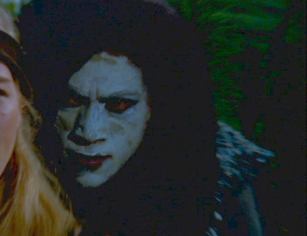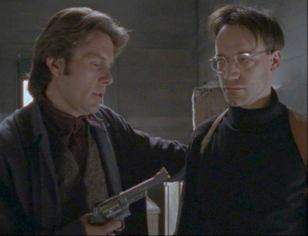The reunion of the world's Amazon tribes to stave off extinction is continued in To Helicon and Back. The title is obviously a play off the 1955 World War II movie about war hero Audie Murphy, and it should also ring another bell: Hercules' journey to the underworld, his rescue of Theseus, and his return that ended in his going mad and killing his family, as depicted in Euripides' Herakles. In this episode it becomes a metaphor for consequences of war, and its impact on the people who wage it, and on the homeland they're fighting for. We should also think of another trip to Hell, Black Orpheus, played out here with Gabrielle travelling to the underworld (of sorts) to rescue the Amazon's fallen Queen, Varia, from the shame of her betrayal. She forgives Varia the way Theseus forgives Hercules (and again, Amazon law is skirted in the name of mercy); the question is, will forgiveness be enough to save the sisterhood of the Amazons? That question is left unanswered in the series.

The prince and his men attack the Amazons in the guise of the figure of Death from Black Orpheus. |
The villain of To Helicon and Back is Bellerophon, whom we remember from myth as the hero who tamed the winged horse, Pegasus. His downfall came when his pride grew so much that he tried to fly to Olympus, and fell to the earth to wander it as a beggar. Pegasus dwelt on Helicon, hence the connection with the title of this episode with Bellerophon, but many have wondered about the changes made to his story: he's the son of Artemis here, and wages war against the Amazons for their abandonment of her; now they've allied with Xena, her murderer during the Twilight of the Gods arc, and he seeks vengeance. Of course, Artemis is the virgin goddess of the hunt, and never had a son or daughter. In fact, Bellerophon was rumored to be the son of Poseidon, of all the gods. Why this change? Perhaps because of Euripides' The Bacchae: Bellerophon is another arrogant prince who seeks to wipe out the women who threaten his world; just as King Penthius hunted down the maenads, so Bellerophon pursues the Xenaverse equivalent. He is made the son of Artemis to emphasize that he, like King Penthius (and like Prince Morloch) is a hunter by nature. In addition, by appointing himself the assassin of his mother's Amazons, he is, like Varia, a misguided hero, destroying his own nation to save it. The Pegasus does not appear here, but we can see its influence in this passage from Graves' The Greek Myths:
| "Iobates, however, far from rewarding Bellerophon for this daring feat, sent him at once against the warlike Solymians and their allies, the Amazons; both of whom he conquered by soaring above them, well out of bowshot, and dropping large boulders on their heads."0101 [footnote: Graves, 75.c] |
The Pegasus is replaced by catapults hurling boulders and arrows at the beach assault the Amazons stage, filmed in the style of the Normandy Invasion that opens Saving Private Ryan. Reading further in The Greek Myths, we can find more clues to how this episode was constructed:
| "Next, in the Lycian Plain of Xanthus, he beat off a band of Carian pirates led by one Cheimarrhus, a fiery and boastful warrior, who sailed in a ship adorned with a lion figurehead and a serpent stern. When Iobates showed no gratitude even then but, on the contrary, sent the palace guards to ambush him on his return, Bellerophon dismounted and prayed that, while he advanced on foot, Poseidon would flood the Xanthian Plain behind him. Poseidon heard his prayer, and sent great waves rolling slowly forward as Bellerophon approached Iobates's palace; and, because no man could persuade him to retire, the Xanthian women hoisted their skirts to the waist and came rushing towards him full butt, offering themselves to him one and all, if only he would relent. Bellerophon's modesty was such that he turned tail and ran; and the waves retreated with him."02 |
Bellerophon's beach assault on Iobates becomes, in To Helicon and Back, the Amazons' beach assault on Bellerophon's castle; the band of pirates become the seafaring Amazons, and their leader is the original pirate leader, Xena from Destiny, inspired from Dionysus the pirate captive in The Cyclops. And who is the Xanthian woman who shows her rear to the enemy? Varia, who wants Bellerophon to relent in his war against a weakened Amazon Nation, and who walks toward, not away from the beach, but turns her back to her enemy in supplication all the same. The correlation is stronger when we read Graves' commentary on these passages:
| "Bellerophon's retreat from the Xanthian women may have been deduced from an icon which showed the Wild Women maddened with hippomanes--either a herb, or the slimy vaginal issue of a mare in heat, or the black membrane cut from the forehead of a new-born foal--closing in on the sacred king by the seashore at the end of his reign. Their skirts were hoisted, as in the erotic worship of Egyptian Apis (Diodorus Siculus: i.85), so that when they dismembered him, his spurting blood would quicken their wombs. Since Xanthus ("yellow") is the name of one of Achilles' horses, and of one belonging to Hector, and of one given to Peleus by Poseidon, these women perhaps wore ritual horse-masks with moon-yellow manes, like those of palominos; for wild mares had eaten Bellerophon's father Glaucus by the seashore of Corinth (see 71.1). Yet this reformed myth retains a primitive element: the approach of naked women from the chieftain's own clan, with whom intercourse was forbidden, would force him to retreat and hide his face, and in Irish legend this same ruse was employed against Cuchulain, when his fury could not otherwise be checked."03 |
At the heart of this myth, in other words, is an ancient gender conflict, and in this episode, instead of "Wild Women," we get Amazons attacked by Wild Men in make up, reminding us of the figure of Death in Black Orpheus. When Bellerophon is finally bested by Xena, he is in position to be beheaded, as is one of his warriors cornered by Gabrielle. She lets him go, not wanting to commit the crime that "Wild Woman" Agave did upon her son in The Bacchae. They attempt to stop the cycle of bloodshed that turns families upon each other, whether it's madness, as in the case of Herakles, or Ares' "favorite kind of war: brother against brother," as we heard in first season's Is There a Doctor in the House?"
Now, it might be thought that this story of Gabrielle's bloodguilt is the natural evolution of her character over the seasons, and that appears the case. But the template for it existed before she ever shed blood in that first episode of the Rosemary's Baby arc, The Deliverer. The arc and the template both came from the same place: American Gothic. Later in the only season of that cancelled series, two episode formed a mini-arc dealing with the same topic that the entire sixth season of Xena did: how to face one's own conscience when wrestling with morally ambiguous issues. The first of these episodes, To Hell and Back, has Sheriff Buck tormenting the idealistic doctor who's been his opponent throughout the series, by dredging up his past responsibility for the death of his family, and using that to cripple him from achieving redemption through penance. The second part, Learning to crawl, is set in a cabin very much like the one in Evil Dead, and features a guest role by Ted Raimi, whose stumbling bank robber character commits his first murder: Sheriff Buck taunts him: "Ted, that man is half-dead. And you half-way took us hostage. I'm gonna call you Half-Ted!" [Yes, Ted Raimi's character is named Ted, and I suspect it's because his brother Sam had already road-tested "Half-Ted" in their youth!] The sheriff is counseling his son and protege, Caleb, on how to avoid letting one's conscience get in the way:
Sheriff Buck: "Let me tell you why Half-Ted here is a failure. You know what a conscience is?"
Caleb: "It's like, uh, when you do something wrong and it bothers you?"
Sheriff Buck: "Well, not me. But see, Half-Ted here has half a conscience. A man with a real conscience never would've gotten himself into this pickle. And a man with no conscience would've killed us all and be in Florida already."
Caleb: "So you're sayin' that Ted's not a bad man?"
Sheriff Buck: "I'm not talkin' 'bout good or bad, son. I'm talking 'bout survival: whole...half. Half is nowhere. Half is...half."
Caleb: "You gotta take it all the way?"
Sheriff Buck: "That's right." |

In To Helicon and Back, Gabrielle is stuck halfway between her former self, and the warrior Xena was, and she is in quite a pickle, as anyone would be. But as Sheriff Buck's chilling instruction implies, it's better to be halfhearted about compromising one's conscience, than taking it all the way, because it's still possible to make it back from Hell.
These two dark episodes are followed by a satyr play that takes us back to the central themes of the show. Send in the Clones is set in a modern-day laboratory which tries to clone Xena and Gabrielle from hair samples found in their tomb. The experiment is successful, but the cloning scientist is revealed to be an incarnation of Alti, who wishes to destroy their reputations that the Xena, Warrior Princess series restored, by unleashing their violent clones to wreak havoc on the streets, thereby ending up on the evening news. We should recognize this plot device from Euripides' Herakles, and at one point, the cloned Gabrielle even evokes his name while watching herself portrayed on the Xena tv series: "What about this writing, Xena? I mean, it's not exactly Euripides. They have taken liberties with my scrolls." The mention of her scrolls tips us off to another play, Sophocles' The Trackers, used in The Xena Scrolls. Instead of resurrecting the past through bits of scrolls, it's done with clips of shows! They reawaken the memories of the cloned heroes, and just as Ares broke free from his imprisonment in The Xena Scrolls, Alti is able to manifest herself in the present. Her twentieth century name is "Alexis Los Alamos," a major clue to where this season is headed. Los Alamos was the location of the laboratory where the Manhattan Project operated in secret during World War II. Its first head, J. Robert Oppenheimer, detonated the first atomic bomb at a nearby location code-named "Trinity," where he uttered the quote about the "Destroyer of Worlds." Alti is conducting a similar experiment here, using science to recreate the human atom bomb that was Xena. The combination of Alti plus reckless cloning of science reminds us of the connection of shamanism and the Nordic arcs on Xena and "Hercules. They were connected by Michael Crichton's Eaters of the Dead, and here, the Crichton connection is Jurassic Park. As one of the fans assisting Alti says at the end: "Well, maybe it was for the best. I mean, we were messing with nature." That's the conclusion of the book as well, and we'll see another satyr play inspired by Jurassic Park later on, right before the series finale.
|

